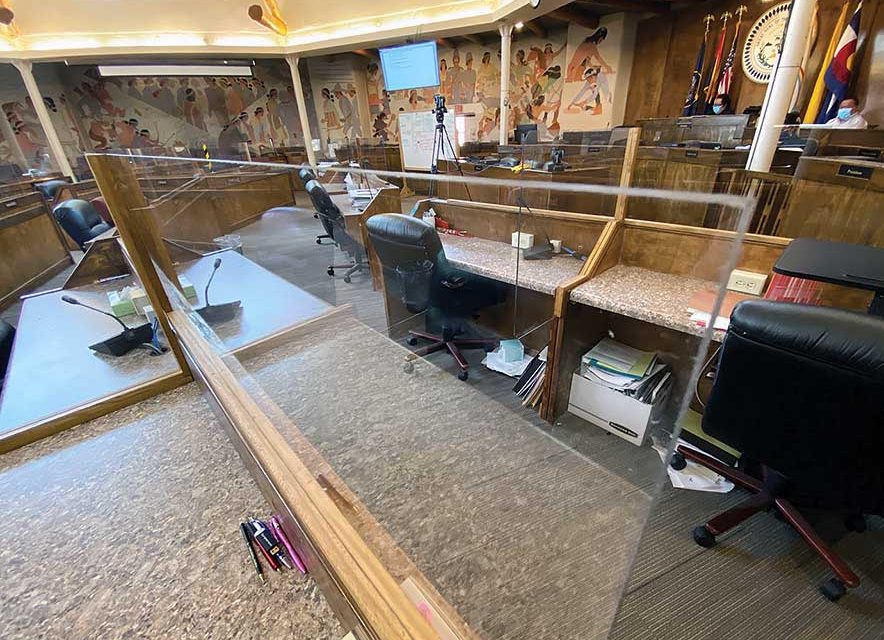
Council tweaks Title II to narrow president’s line-item veto authority

Navajo Times | Donovan Quintero
A plexiglass panel used to prevent the spread of COVID-19 sits on a Navajo Nation Council delegate’s table on Tuesday in Window Rock. During the summer session, Council members have been conducting Council business from their homes. Presiding over the empty Council Chamber, Speaker Seth Damon is seated second from right.
WINDOW ROCK
Ever since the Navajo Nation voted to give the Navajo President line-item veto power through an initiative in 2009, the Navajo Nation Council has accused the president of abusing that power.
The 24 th Navajo Nation Council its no different. These lawmakers saw a problem with President Jonathan Nez using his line-item veto authority on resolutions pertaining to the Coronavirus Aid, Relief and Economic Security Act funds. During the last day of the Navajo Nation Council Summer Session Wednesday, delegates decided to amend Title II pertaining to the line-item veto power.The legislation, 0153-20, was sponsored by Health, Education, Human Services Committee Chair Daniel Tso and co-sponsored by Speaker Seth Damon.
The amendment, which passed 18-4, tweaks Title II’s wording to state: “The President is authorized to exercise line-item veto authority over budget items contained in the annual Navajo Nation Comprehensive Budget or supplemental appropriation approved by the Navajo Nation; budget line items vetoed by the President will not be subject to Council’s override.” The amendment is direct and clear as to what the president’s line-item veto will be used for, as opposed to the original language, which made the president’s “financial line-item vetoes” override-proof.
Tso argued the word “financial” could be interpreted very broadly and is not what the referendum intended. The referendum gives the president veto authority over “budget line items,” which is not the same thing as any financial matters that come up.
“We have a president that basically overstruck legislative language in concert with proposed expenditure plans,” said Tso during the July 14 Budget and Finance meeting. “Those languages were never part of the supplemental appropriation. Not a part of the comprehensive budget. He overstepped his authority.”
The resolution Tso was referring to was CMY-44-20, which created the framework for spending the $714 million in CARES Act funding the Navajo Nation received from the federal government
. He also said Nez had done this with other bills as well. Nez justified his line-item veto by saying an amendment Council had placed on the resolution made it into an appropriation, which gave him the authority to use his line item veto power.
“I respect what you are doing,” said Delegate Elmer Begay to Tso during the same Budget and Finance meeting. “When are we going to use the judicial branch, Supreme Court to interpret the law? We need to stop these presidents … We need the courts to look at it.”
Seeing it a lot differently, Nez said the Council has always challenged the line-item veto power ever since the referendum passed. He also reiterated the CARES funds have certain guidelines that need to be followed and he used his veto pen liberally because some of the Council’s ideas violated the guidelines.
“The people wanted to hold their leaders accountable when there was discretionary fund issues,” said Nez. “So when they put it to the vote they gave the president line-item veto ability because of what Council was doing of mismanaging and misappropriating dollars.”
The ballot language that was used in the 2009 referendum, Tso explained, is different from what is written in the code. So by amending the language it would be aligned to what the voters had actually voted on over 10 years ago.
As a public service, the Navajo Times is making all coverage of the coronavirus pandemic fully available on its website. Please support the Times by subscribing.
How to protect yourself and others.
Why masks work. Which masks are best.
Resources for coronavirus assistance
“That referendum was certified. We have to realize the legislative staff aren’t responsible for the publication of these actions into the Navajo Nation Code,” said Tso. “Possibly it was a human error, grammatical errors, or interpretation. I’m sure the proofreaders missed the particular aspect. That’s why there’s a difference between what the voters voted on and what was published into that particular Title II.”
Tso said when he asked Chief Legislative Counsel Dana Bobroff about this, she clarified it for him. She later explained the language in the code and ballot language did not match, and the amendment would rectify that error.
But Nez argued that codifying the language of the 2009 referendum would make it subject to amendments by the Navajo Nation Council. This would eliminate the Navajo people’s right to repeal or amend the line-item veto initiative by another referendum, which is generally the only way to take back legislation that passes by referendum.
“With the CARES Act now there are certain guidelines and restrictions to the money and we have to follow that,” said Nez. “They (Council) want to take full oversight over the people’s money and take on executive branch authority. The Navajo people are the only one who can clarify it. But every president since the approval has gone through this. That’s a check and balance put in by the Navajo people.”
Before delegates voted in favor of this legislation Wednesday, Attorney General Doreen McPaul said she would be presenting a report on the matter in executive session.








 Highway 264,
Highway 264, I-40, WB @ Winslow
I-40, WB @ Winslow